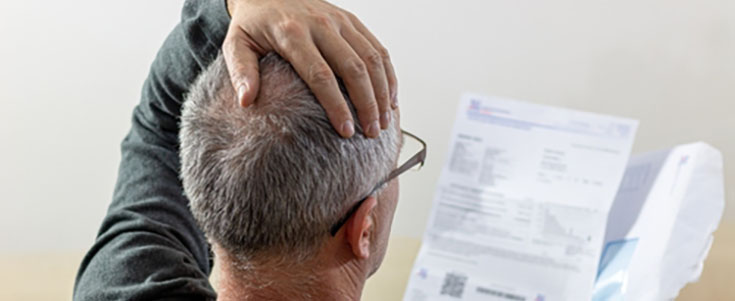3 common pension tax traps and how you can avoid them

If you are getting close to your anticipated retirement date, it’s highly likely that you’ll be thinking about drawing money from your accrued pension fund – either as a lump sum or regular income.
It’s important to plan this carefully as there are some potential tax traps you could fall into. These could result in you receiving an unexpected and unwelcome tax bill or overpaying tax and having to claim a refund from HMRC.
On the latter point, figures published by Money Age [1] reveal HMRC repaid £134 million in overpaid pension tax in 2022 alone.
Given this, it makes sound financial sense to plan ahead rather than simply leaving things to chance. Yet, research published by Actuarial Post [2] confirmed that in the 2021/22 tax year, only 1 in 3 people took financial advice before accessing their pensions.
Discover three common pension tax traps and how you can avoid falling into them.
1. Taking your pension as a single lump sum
Pension Freedoms legislation, introduced in 2015, allows a remarkable amount of flexibility when it comes to how and when you take money from your pension fund.
In fact, there are really only two restrictions:
- You can’t start drawing money until you reach age 55, rising to age 57 in 2028
- Only 25% of your fund can be taken free of tax. The balance will effectively be treated as income and taxed accordingly.
When the time comes, you may be planning to take a substantial lump sum from your fund, or even all of it in one go.
You might have good reason for doing this. For example, you may have a specific need already earmarked, or you may be thinking of putting it with your other savings and investments in a single account.
Before you do this, it’s important to consider the tax implications.
As you’ve already read, the bulk of such a lump sum will be taxed as income at your marginal rate. Withdrawing a lot of money in one go, could tip you into a higher tax bracket and could mean you end up paying 40% or 45% tax on the amount you draw.
As a result, you could lose a substantial amount of your retirement fund to HMRC.
To avoid this possibility, it’s important to plan ahead, and take the effects of taxation into account, especially if you hope to draw large sums from your pension fund.
This also demonstrates the importance of having a tax-efficient income strategy in place when you do retire.
2. Overpaying tax on your first pension withdrawal
As well as getting a nasty tax shock by taking a big lump sum from your pension fund, you may also get another unwanted surprise when you look at your tax code, which determines how much tax you’ll be paying in a tax year.
If you draw a lump sum from your fund at outset you could easily be put on an emergency tax code.
This effectively treats any lump sum as monthly income and assumes that you’ll be taking the same amount in each subsequent month. Your tax code is assessed accordingly, with the result that you’re likely to be paying a higher rate of tax than you ought to be.
According to a report from This is Money [3], since Pension Freedoms was introduced, people have had to claim back £925 million – often as a result of an emergency tax code.
The good news is that you can claim any tax you overpay back from HMRC using the form appropriate to your circumstances.
There are three such forms, which you can find on the government website:
- P50Z – if the payment used up your entire pension pot and you have no other income in the tax year
- P53Z – if the payment used up your entire pension pot and you have other taxable income
- P55 – if you have withdrawn only part of your pot and you're not taking regular payments.
Should you find you need to claim tax back, this is likely to take some time. This may mean that your ongoing income could be affected and you might find yourself with a shortfall for several months.
To help mitigate against the effects of an emergency tax code, it’s important to be aware of this possibility and plan ahead wherever possible.
If you have the flexibility, you could consider taking a smaller sum than you’d originally planned, or simply set up a monthly income at outset. If you’re concerned about falling into this tax trap and would like to talk about your options, please get in touch.
3. Triggering the Money Purchase Annual Allowance on your pension contributions
In the 2023/24 tax year, the Annual Allowance, which is the amount you can contribute into a personal pension and receive tax relief on, is £60,000 or 100% of your total earnings, whichever is lower.
However, once you start drawing from your pension, the amount you can contribute and receive tax relief on falls to just £10,000. This is due to the Money Purchase Annual Allowance (MPAA).
As a result, any contributions to your pension that exceed the MPAA could incur an additional tax charge.
This could be a particular issue if you start to draw from your pension fund before you finish working.
A phased retirement has become an increasingly popular option. Indeed, research carried out by Legal & General [4] revealed that more than a third of people over the age of 55 had started to reduce their working hours prior to eventually retiring, rather than simply stopping work one day and starting their retirement the next.
However, doing so may mean that you start to draw a relatively small amount of income from your pension fund to make up for any shortfall in your monthly salary.
Pension Freedoms legislation was intended to help facilitate this kind of flexibility, but it’s crucial to be aware that drawing on your pension reduces the amount you can subsequently contribute to it tax-efficiently.
This means that it’s important to keep a record of contributions you are making to be sure that you don’t accidentally find yourself in this position.
You should also be aware of the maximum tax-free cash you’re entitled to
While it’s not a tax trap as such, a new limit came into effect at the start of the 2023/24 tax year.
This relates to the amount of tax-free cash you can take from your pension fund.
The limit on the total you can tax-efficiently accrue in your pension fund – known as your “Lifetime Allowance” (LTA) – was removed from 6 April 2023.
However, although there is now no limit on the size of your pension fund, your maximum tax-free cash entitlement has been fixed at £268,275.
Get in touch
If you’d like to find out more about how we can help you plan your retirement income effectively and avoid the traps you’ve read about here, please get in touch.
Email info@aspirafp.co.uk or call us on 0800 048 0150.
Please note
The information contained in this article is based on the opinion of Aspira and does not constitute financial advice or a recommendation to any investment or retirement strategy. You should seek independent financial advice before embarking on any course of action.
This article is for information only. Please do not act based on anything you might read in this article. All contents are based on our understanding of HMRC legislation, which is subject to change.
A pension is a long-term investment. The fund value may fluctuate and can go down, which would have an impact on the level of pension benefits available. Your pension income could also be affected by the interest rates at the time you take your benefits.
Sources:
[1] Money Age - https://moneyage.co.uk/hmrc-repays-134m-in-overpaid-pensions-tax-in-2022...
[2] Actuarial Post - https://www.actuarialpost.co.uk/article/rise-of-the-diy-pension-dipper--...
[3] This is Money - https://www.thisismoney.co.uk/money/pensions/article-11457463/Quiet-scan...
[4] Legal & General - https://group.legalandgeneral.com/en/newsroom/press-releases/millions-of...





Submit a comment